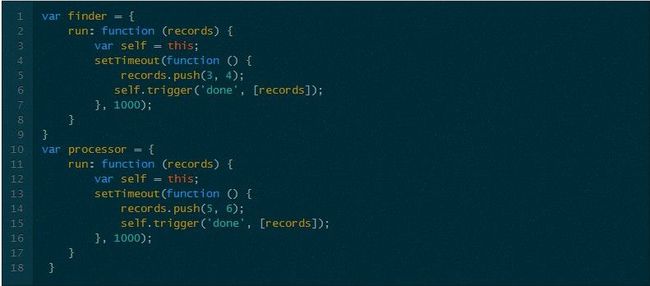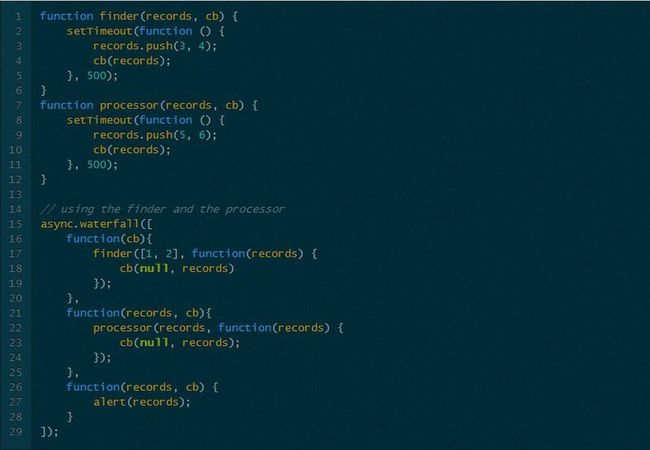Javascript Asynchonous Progamming
Asynchronous JS: Callbacks, Listeners, Control Flow Libs and Promises
When it comes to dealing with asynchronous development in JavaScript there are many tool you can use. This post explains four of these tools and what their advantages are. These are Callbacks, Listeners, Control Flow Libraries and Promises.
Example Scenario
To illustrate the use of these four tools, let’s create a simple example scenario.
Let’s say that we want to find some records, then process them and finally return the processed results. Both operations (find and process) are asynchronous.
Photo credit: bitzcelt / Foter / CC BY-NC-ND
Callbacks
Let’s start with callback pattern, this is the most basic and the best known pattern to deal with async programming.
A callback looks like this:
 SetupIn the callback pattern we call a function that will do the asynchronous operation. One of the parameters we pass is a function that will be called when the operation is done.
SetupIn the callback pattern we call a function that will do the asynchronous operation. One of the parameters we pass is a function that will be called when the operation is done.
In order to illustrate how they work we need a couple of functions that will find and process the records. In the real world these functions will make an AJAX request and return the results, but for now let’s just use timeouts.
 The code that consumes these functions looks like this:Using the callbacks
The code that consumes these functions looks like this:Using the callbacks
 We call the first function, passing a callback. Inside this callback we call the second function passing another callback.
We call the first function, passing a callback. Inside this callback we call the second function passing another callback.
These nested callbacks can be written more clearly by passing a reference to another function.
In both case the console log above with log [1,2,3,4,5,6]
Working example here:
// setup
function finder(records, cb) {
setTimeout(function () {
records.push(3, 4);
cb(records);
}, 500);
}
function processor(records, cb) {
setTimeout(function () {
records.push(5, 6); cb(records);
}, 500);
}
// using the callbacksfinder([1, 2],
function (records) {
processor(records, function(records) {
console.log(records);
});
});
// or
function onProcessorDone(records){
alert(records);
}
function onFinderDone(records) {
processor(records, onProcessorDone);
}
finder([1, 2], onFinderDone);
Pros
They are a very well know pattern, so they are familiar thus easy to understand.
Very easy to implement in your own libraries / functions.
Cons
Nested callbacks will form the infamous pyramid of doom as shown above, which can get hard to read when you have multiple nested levels. But this is quite easy to fix by splitting the functions also as shown above.
You can only pass one callback for a given event, this can be a big limitation in many cases.
Photo credit: Brandon Christopher Warren / Foter / CC BY-NC
Listeners
Listeners are also a well known pattern, mostly made popular by jQuery and other DOM libraries. A Listener might look like this:
 SetupWe call a function on an object that adds a listener. In that function we pass the name of the event we want to listen to and a callback function. ‘on’ is one of many common name for this function, other common names you will come across are ‘bind’, ‘listen’, ‘addEventListener’, ‘observe’.
SetupWe call a function on an object that adds a listener. In that function we pass the name of the event we want to listen to and a callback function. ‘on’ is one of many common name for this function, other common names you will come across are ‘bind’, ‘listen’, ‘addEventListener’, ‘observe’.
Let’s do some setup for a listener demonstration. Unfortunately the setup needed is a bit more involving than in the callbacks example.
First we need a couple of objects that will do the work of finding and processing the records.
 |
Note that they are calling a method trigger when the work is done, I will add this method to these objects using a mix-in. Again ‘trigger’ is one of the names you will come across, others common names are ‘fire’ and ‘publish’.
We need a mix-in object that has the listener behaviour, in this case I will just lean on jQuery for this:
Then apply the behaviour to our finder and processor objects:
Excellent, now our objects can take listeners and trigger events.
Using the listeners
The code that consumes the listeners is simple:
 Again the console run will output [1,2,3,4,5,6]
Again the console run will output [1,2,3,4,5,6]
Working example here:
// using listeners
var eventable = {
on: function(event, cb) {
$(this).on(event, cb);
},
trigger: function (event, args) {
$(this).trigger(event, args);
}
}
var finder = {
run: function (records) { var self = this; setTimeout(function () {
records.push(3, 4); self.trigger('done', [records]);
}, 500);
}
}
var processor = {
run: function (records) { var self = this; setTimeout(function () {
records.push(5, 6); self.trigger('done', [records]);
}, 500);
}
}
$.extend(finder, eventable);
$.extend(processor, eventable);
finder.on('done', function (event, records) {
processor.run(records);
});
processor.on('done', function (event, records) { alert(records);
});
finder.run([1,2]);
Pros
This is another well understood pattern.
The big advantage is that you are not limited to one listener per object, you can add as many listeners as you want. E.g.
 A bit more difficult to setup than callbacks in your own code, you will probably want to use a library e.g. jQuery, bean.js.Cons
A bit more difficult to setup than callbacks in your own code, you will probably want to use a library e.g. jQuery, bean.js.Cons
Photo credit: Nod Young / Foter / CC BY-NC-SA
A Flow Control Library
Flow control libraries are also a very nice way to deal with asynchronous code. One I particularly like is Async.js.
Code using Async.js looks like this:
 Again we need a couple of functions that will do the work, as in the other examples these functions in the real world will probably make an AjAX request and return the results. For now let’s just use timeouts.Setup (Example 1)
Again we need a couple of functions that will do the work, as in the other examples these functions in the real world will probably make an AjAX request and return the results. For now let’s just use timeouts.Setup (Example 1)
 Note the style used in the callbacks inside the functions above.The Node Continuation Passing Style
Note the style used in the callbacks inside the functions above.The Node Continuation Passing Style
![]() Using AsyncThe first argument in the callback is null if no error occurs; or the error if one occurs. This is a common pattern in Node.js libraries and Async.js uses this pattern. By using this style the flow between Async.js and the callbacks becomes super simple.
Using AsyncThe first argument in the callback is null if no error occurs; or the error if one occurs. This is a common pattern in Node.js libraries and Async.js uses this pattern. By using this style the flow between Async.js and the callbacks becomes super simple.
The code that will consume these functions looks like this:
 Working example here:Async.js takes care of calling each function in order after the previous one has finished. Note how we can just pass the ‘processor’ function, this is because we are using the Node continuation style. As you can see this code is quite minimal and easy to understand.
Working example here:Async.js takes care of calling each function in order after the previous one has finished. Note how we can just pass the ‘processor’ function, this is because we are using the Node continuation style. As you can see this code is quite minimal and easy to understand.
Working example here:
// setup
function finder(records, cb) { setTimeout(function () {
records.push(3, 4); cb(null, records);
}, 500);
}
function processor(records, cb) { setTimeout(function () {
records.push(5, 6); cb(null, records);
}, 500);
}
async.waterfall([ function(cb){ finder([1, 2], cb);
},
processor
, function(records, cb) { alert(records);
}
]);
Another setup (Example 2)
Now, when doing front-end development it is unlikely that you will have a library that follows the callback(null, results) signature. So a more realistic example will look like this:
 Working example here:It becomes a lot more convoluted but at least you can see the flow going from top to bottom.
Working example here:It becomes a lot more convoluted but at least you can see the flow going from top to bottom.
Working example here:
// setup
function finder(records, cb) { setTimeout(function () {
records.push(3, 4); cb(records);
}, 500);
}
function processor(records, cb) { setTimeout(function () {
records.push(5, 6); cb(records);
}, 500);
}
async.waterfall([ function(cb){ finder([1, 2], function(records) { cb(null, records)
});
}, function(records, cb){ processor(records, function(records) { cb(null, records);
});
}, function(records, cb) { alert(records);
}
]);
Pros
Usually code using a control flow library is easier to understand because it follows a natural order (from top to bottom). This is not true with callbacks and listeners.
Cons
If the signatures of the functions don’t match as in the second example then you can argue that the flow control library offers little in terms of readability.
Photo credit: Helmut Kaczmarek / Foter / CC BY-NC-SA
Promises
Finally we get to our final destination. Promises are a very powerful tool, but they are the least understood.
Code using promises may look like this:
 SetupThis will vary widely depending on the promises library you use, in this case I am using when.js.
SetupThis will vary widely depending on the promises library you use, in this case I am using when.js.
Out finder and processor functions look like this:
 Using the promisesEach function creates a deferred object and returns a promise. Then it resolves the deferred when the results arrive.
Using the promisesEach function creates a deferred object and returns a promise. Then it resolves the deferred when the results arrive.
The code that consumes these functions looks like this:
 Working example here:As you can see, it is quite minimal and easy to understand. When used like this, promises bring a lot of clarity to your code as they follow a natural flow. Note how in the first callback we can simply pass the ‘processor’ function. This is because this function returns a promise itself so everything will just flow nicely.
Working example here:As you can see, it is quite minimal and easy to understand. When used like this, promises bring a lot of clarity to your code as they follow a natural flow. Note how in the first callback we can simply pass the ‘processor’ function. This is because this function returns a promise itself so everything will just flow nicely.
Working example here:
// using promises
function finder(records){ var deferred = when.defer(); setTimeout(function () {
records.push(3, 4);
deferred.resolve(records);
}, 500); return deferred.promise;
}
function processor(records) { var deferred = when.defer(); setTimeout(function () {
records.push(5, 6);
deferred.resolve(records);
}, 500); return deferred.promise;
}
finder([1,2])
.then(processor)
.then(function(records) { alert(records);
});
There is a lot to promises:
they can be passed around as regular objects
aggregated into bigger promises
you can add handlers for failed promises
The big benefit of promises
Now if you think that this is all there is to promises you are missing what I consider the biggest advantage. Promises have a neat trick that neither callbacks, listeners or control flows can do. You can add a listener to promise even when it has already been resolved, in this case that listener will trigger immediately, meaning that you don’t have to worry if the event has already happened when you add the listener. This works the same for aggregated promises. Let me show you an example of this:
function log(msg) {
document.write(msg + '<br />');
}
// using promises
function finder(records){ var deferred = when.defer(); setTimeout(function () {
records.push(3, 4); log('records found - resolving promise');
deferred.resolve(records);
}, 100); return deferred.promise;
}var promise = finder([1,2]);
// wait
setTimeout(function () {
// when this is called the finder promise has already been resolved
promise.then(function (records) { log('records received');
});
}, 1500);
This is a huge feature for dealing with user interaction in the browser. In complex applications you may not now the order of actions that the user will take, so you can use promises to track use interaction. See this other post if interested.
Pros
Really powerful, you can aggregate promises, pass them around, or add listeners when already resolved.
Cons
The least understood of all these tools.
They can get difficult to track when you have lots of aggregated promises with added listeners along the way.
Conclusion
That’s it! These are in my opinion the four main tools for dealing with asynchronous code. Hopefully I have help you to understand them better and gave you more options for you asynchronous needs.





